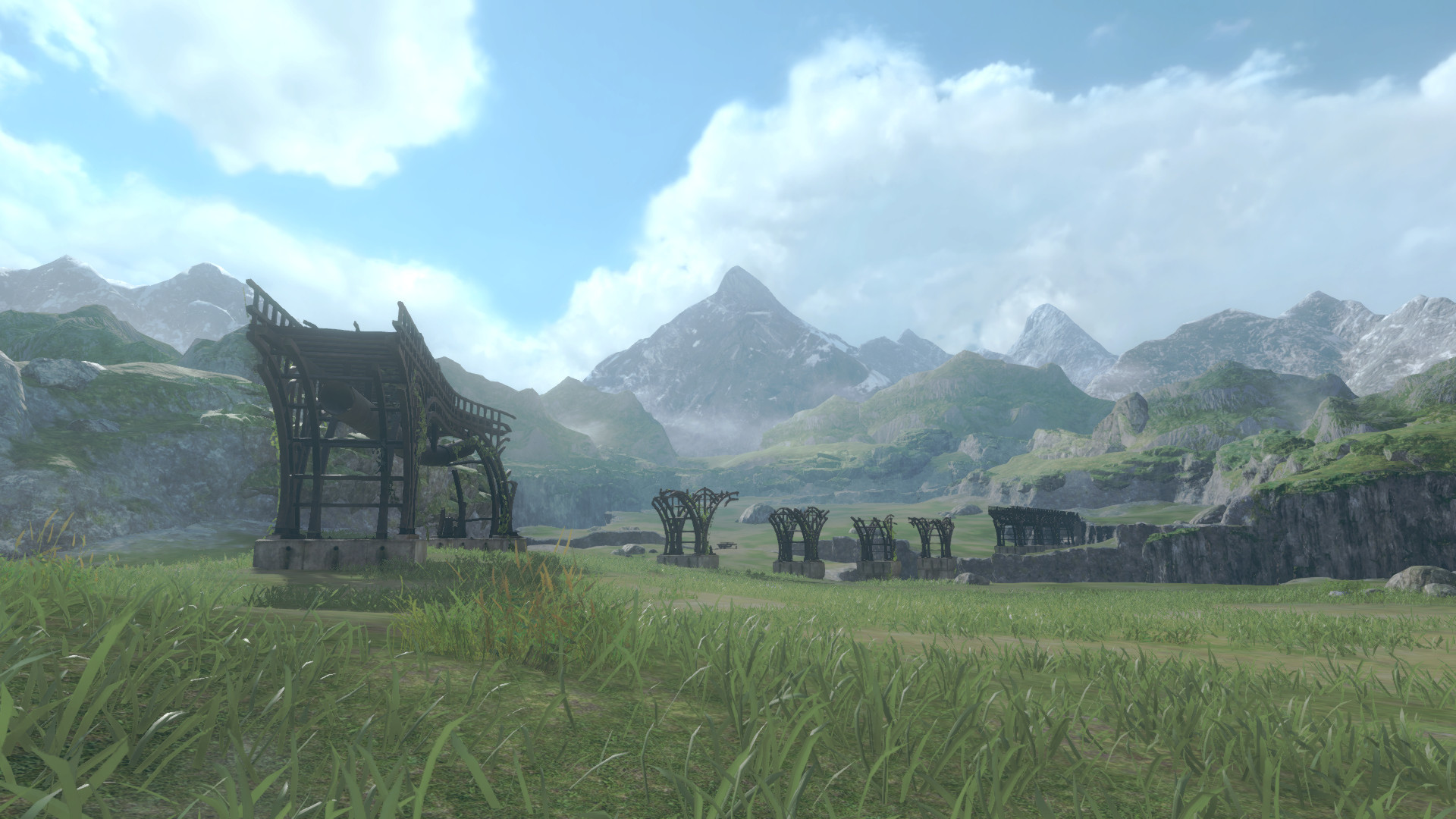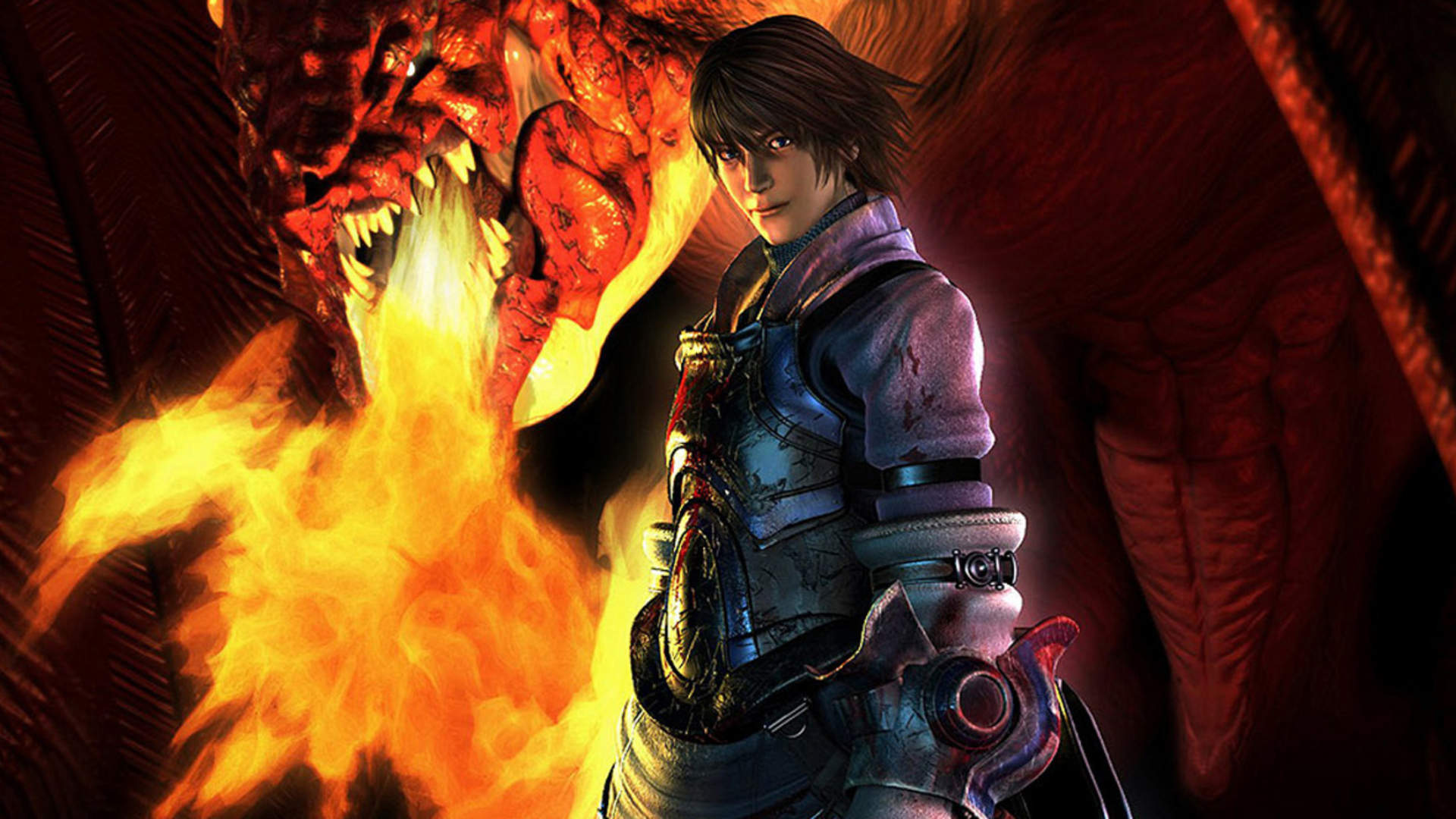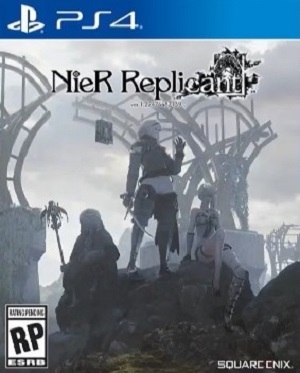
NieR Replicant ver.1.22474487139… released on PS4, Xbox One and PC on April 23rd, and introduced fans of NieR: Automata to the original masterpiece of despair. The remaster/“upgrade” improves the visuals and combat along with full voice work, rearranged music and new tracks. But perhaps most importantly, it adds new story content. No, we’re not just talking about a new boss based on “The Little Mermaid” novella from Grimoire NieR. There’s a brand new ending which is available after Ending D once your save data has been deleted.
Suffice it to say that major spoilers follow so you’ve been warned. It also helps to have knowledge of the events of Drakengard 1 and 3 along with the NieR games. Seriously.
After deleting one’s save data, starting a new game with a new name will commence an entirely different route. It starts with Kaine who, despite being alive, suffers from nightmares and seems to recall losing something precious to her. She then embarks on her own and hears about Shades in the Forest of Myth. Upon arriving in the forest, it appears to have been overrun with machines. After disposing several machine foes, Kaine delves deeper into a tree while two mysterious voices blame her for destroying the Original Gestalt, causing the various Gestalts to run wild and slaughtering several Replicants.
Eventually, she arrives at a mysterious facility where two machine twins emerge and will look very familiar to those who played NieR: Automata. These twins are the administrators of a data terminal and have long been watching and listening to the so-called “recycled world” (with the forest itself recording “anything and everything about the world”). Kaine disposes of a machine boss before eventually fighting against android copies of herself created through Maso particles. Before she’s totally overwhelmed, Emil – thought to be dead – arrives to help her, eventually breaking through to a doorway that leads to “that which was lost.”
This new area resembles the aesthetic of the Copied City from NieR: Automata. As Kaine and Emil traverse its walkways, they both have the feeling of forgetting something really important. They come across a replication of the Shadowlord’s castle and battle the “core frame” of the forest which stores a great variety of information, including Kaine’s lost memories. As she damages the frame, the forgotten protagonist’s voice rings out.
Upon destroying the frame, Kaine suddenly ends up in a virtual space that encompasses her memories (with her health bar looking more like that from NieR: Automata). She battles Shades along with reconstructed versions of old bosses, including Hook who killed Kaine’s grandmother. Old memories of abuse at the hands of different villagers begin to emerge before Kaine eventually collapses. What follows is a text adventure where she awakens in the Aerie.
Her grandmother is alive and everything seems well. Of course, this doesn’t last as the village, its residents and eventually her grandmother are all obliterated. Just when things seem hopeless, however, who should speak out but Grimoire Weiss who reminds Kaine of her goal.
Suddenly, she’s back in the virtual space with Weiss by her side, ready to fight Hook with magic. The duo eventually take it down, and the administrator twins begin to dissipate, awed by the potential of a Replicant. They note that “possible futures are blending with the time we currently inhabit” before remarking that they “hear a song.”
Kaine then finally remembers the protagonist and all of their trials and tribulations together while cursing him to finally return. She then comes across the protagonist’s body and the player is given the choice to recover the person they cherish most. The deleted save data from Ending D is restored and everything from the menus, weapons collected and abilities to the maps and tutorials returns.
Grimoire Weiss departs and a giant flower resembling a Lunar Tear blooms. Kaine and the protagonist are in the middle of it, with the latter reverting to the state in which they first met. Kaine and Emil then speak about the past being a mistake and the journey being meaningless but vowing to carry on, even if the world ends, for the sake of those they cherish.
There’s a lot to unpack here. You could just call this ending an attempt to provide some kind of happy conclusion for NieR Replicant fans. However, it’s actually based on another novella from Grimoire NieR called “The Lost World.” This story sees Kaine venturing to the Forest of Myth and encountering the overseer who states that the forest is actually a computer where “the ancient people” studied the demonic element (implied to be Maso) and quantum physics.
The overseer is an existence akin to Grimoire Weiss who apparently controls all of the demonic elements along with the life and death of the Gestalts and Replicants. He notes that the world is a “failure” and that robots and humans aren’t needed. After Kaine fights to recover her memories of the protagonist and save him, the Lunar Tear is formed and they’re reunited.
However, in NieR Replicant ver.1.22474487139…, the whole route serves to directly connect the game to NieR: Automata, specifically with the administrator twins. These are theorized to be Number 2 and Number 9 which would form the basis for 2B and 9S (as their appearances imply). The fact that Kira Buckland and Kyle McCarley return to voice these characters lends further credence to this theory. This is where things get a little weird though.
The “flower” seen at the end could just be a giant Lunar Tear, which appears throughout NieR. However, it also resembles the Flower from Drakengard 3 which bloomed in its protagonist Zero’s right eye and was responsible for much of the evil events in that game. When all was said and done, the Accord revealed that the Flower had been sealed. She then adds that it may reappear in another time and place while Zero, who had allowed the Flower to bloom within her, could still be alive.
Drakengard 3 is a prequel though. In Drakengard 1, the antagonists are the Watchers whom the Empire tries to summon by breaking the Seals and thus having them destroy Midgard. In the fifth and final ending, Caim and his dragon Angelus fight against the Queen-beast (theorized to be Zero from Ending D of Drakengard 3) in modern day Tokyo. The death of the Dragon and the Giant, as they were referred to in NieR, would directly lead to the creation of Maso, Project Gestalt and the Legions among other things.
Given that the Watchers could be summoned by the Intoners, whom Zero fought against in Drakengard 3, along with their Disciples, it seems like a decent enough connection between the two games. Right?
However, things are never that simple. In the book Drakengard 3: The Complete Guide + Settings where novelist Eishima Jun – who wrote the Drakengard 3 side stories – novelist Matsushita Ayaki and NieR/Drakengard scenario writer Natori Sawako discussed the connections between Drakengard 1 and 3. As per Eishima, Taro never said that any of Drakengard 3’s endings directly tie into Drakengard 1. Ending A of the former is connected to Drakengard 1.3, a series of short stories with its own timeline and continuity separate from the first game.
Something or the other happens in each branch of Drakengard 3 that makes it impossible to directly connect to Drakengard 1. The only real clue seems to be the Intoners, their relationship with the Watchers and Zero potentially being the Queen-beast.
Let’s go back to Ending E of NieR Replicant ver.1.22474487139… where the twins talk about “possible futures blending with the time we currently inhabit” and then hearing a song. The first part could refer to Kaine’s actions creating a new timeline – which wouldn’t be too far off, considering the number of changes that have happened based on different endings and branches in previous games. This could be the new timeline where the Flower re-emerges, playing off of a set of possibilities and results occurring after the Dragon and the Giant died.
As for the song, the Intoners were capable of harnessing the Power of Songs which granted immense fighting strength and unique abilities. It can also be used to bring back the dead. The Queen-beast in Drakengard 1 was also capable of wielding the Power of Songs and it’s known that the Flower can resurrect its host. Assuming the Flower was still within Zero when she theoretically became the Queen-beast, it’s possible that it wasn’t completely destroyed by Angelus. The twins hearing a “song” could be in reference to the Flower singing.
It’s also worth discussing Singularities, the beings capable of creating new branches. Whenever a timeline has split into a new branch, it’s called a “shift.” These can only be triggered when a “certain amount of Maso has been gathered” as per Eishima in the guide book. A Singularity isn’t recorded as such until a new branch is created. So it’s possible that Kaine became a Singularity like Zero and caused a shift in the NieR Replicant ver.1.22474487139… timeline but only after the fact.
So to roughly summarize: Drakengard 1 is confirmed to tie into NieR Replicant’s Ending D, which leads to NieR: Automata. However, slight aspects of Drakengard 3 presumably tie into Drakengard 1 and seem to connect to NieR Replicant’s Ending E. This is speculation though and there are many more questions to ask with how Ending E was ultimately handled.
If a new timeline has theoretically been created and the twins have been eradicated, then do the events of NieR: Automata not take place? The short stories, which do lead directly to Automata, only have the singular overseer of the Forest of Myth. What was the point of including Number 2 and Number 9 if they were only to be removed from the equation?
Perhaps these aren’t even the true versions of the twins, especially since the YoRHa androids first entered development in the year 11937 (while NieR Replicant‘s story began in 2053). Does Kaine have any direct connection to Zero? The android copies of her having glowing right eyes – the same location where the Flower resided on Zero – wasn’t exactly subtle.
Now for the real question: Could there be another sequel that carries on events after Ending E? As is usually the case with Yoko Taro’s works, it’s definitely possible. That being said, it may not even be a direct sequel, instead tying in through various other ways while presenting its own unique tale set hundreds or thousands of years later.
Taro’s approach within Drakengard’s continuity indicates a desire to not directly connect everything, instead presenting bits and pieces while leaving it to fans to draw their own conclusions. Drakengard 1, NieR and NieR: Automata deviated from this by being directly connected to each other though, again, through different endings.
One thing is for sure though – as the themes of identity, existence and love persist through each game, so too will the unending cycle of hope and despair. There are still so many potential threads to explore, from the Accord to the true nature of the Seeds of Destruction. At least we can rest assured that throughout it all, Taro and friends will find some way to utterly ruin our emotions yet again.


















